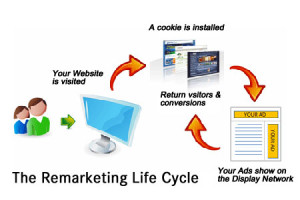Digital Remarketing: Awesome Cookies
Remarketing should be an important part of any brands’ digital marketing strategies. People who have already visited your website, obviously have an interest in your product or service. These prospects are often called “low-hanging fruit” – meaning ripe and easy to reach. When someone visits your site, their initial experience with your brand may not be enough for him or her to make a decision and take action. That’s where remarketing comes in.
In a nutshell, remarketing puts a Google AdWords or Analytics code (tag) on a webpage that places a digital “cookie” on a visitor’s browser. That cookie is then used to allow a digital marketer to target that user through paid search and display ads as they surf the Web. Remarketing lists are created based on the way that pages and actions on a Web page are tagged. The more tagged pages and actions, the more information can be learned about a customer. If a specific product page is tagged and the buy-flow is tagged, then it becomes apparent which product (or product category) the user was interested in. This type of visitor can now be targeted differently than someone who just visited the homepage and bounced. You can create and serve ads that cater to their specific interests or needs. With remarketing, your audience can also be targeted by demographics, behavior and interest categories.
A few years ago, only large companies could afford to invest in data mining, but small businesses across all industries (b2b and b2c) now have access to the tracking tools necessary to take advantage of digital remarketing. With user-friendly, third-party tools and services readily available from companies like Google and Facebook, your company can quickly and easily incorporate highly-targeted remarketing campaigns into your existing media mix.
Search ads are a great way to help increase site traffic. They have a very high conversion rate inherent in the fact that someone is executing a specific keyword search. However, it’s difficult to build a brand using tiny text ads and search listings, which have a limited amount of character space and don’t support logos and other visual elements. On the other hand, digital remarketing is a great way to build brand recognition, increase conversion rates and complement your search programs. There’s so much more you can do creatively with a remarketing display ad that will make potential customers remember you.
Some naysayers are afraid of remarketing and think it’s creepy to follow (stalk) people on the Web. However, those people may not fully understand how it works or recognize the true power of remarketing. Conversion rates actually increase the more users see an ad within remarketing campaigns. Over time, it’s true that click-through rates decline, but those people who do click, after having seen it a few times already, become twice as likely to convert. If you’re concerned about annoying prospects, you can alternate ad creative and/or set up ad impression frequency caps (limiting the number of times your ads are seen). There are thousands of companies worldwide who have implemented successful remarketing programs and can attest to the fact that cookies can be a simply delicious sales tool.
If you want to launch a remarketing campaign, consider a multi-channel strategy. Most businesses choose a specific channel, such as display, banner, Facebook or video ads. However, consumers aren’t on just one channel. Do you watch only one channel on television?
So, where will you get the most bang for your buck? Right now, the Google Display Network (GDN) and Facebook offer the greatest reach for your remarketing campaigns. With over 2 million sites, Google reports that GDN reaches 90% of Internet users worldwide, 65% of whom they reach every single day. More than a trillion impressions are served to over a billion users every month. Meanwhile, Facebook reports having more than 1.4 billion users, over a billion of whom logged in yesterday.
Lastly, don’t be afraid of trial and error. What you thought at the outset about your product and how people will use it may continually change. The key is to monitor and make adjustments often; it’s not a set-it and forget-it type of program, which is why most marketers prefer to engage an experienced agency with a Google Certified Professional who can review and refine their campaigns as they go along. Through trial and error and careful review of your analytic tools, you can see which remarketing ads are yielding the best click-thru rates, which keywords, phrases and topics are the most popular, which pages of your site lead to the highest conversions, etc.
Remarketing is not scary or creepy. Most savvy marketers recognize that it’s a highly-targeted “must-have” ingredient in their ever-evolving digital marketing recipe.






